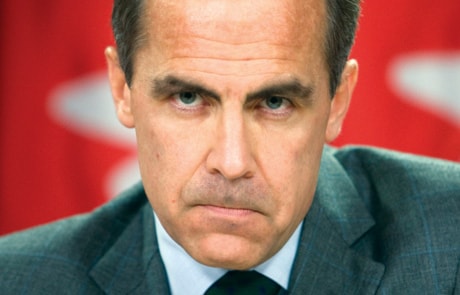OTTAWA — The stubbornly strong loonie is the major impediment to the Canadian economy rebounding more strongly from the recent deep recession, says Bank of Canada governor Mark Carney.
In a new warning about the currency that is approaching parity with the U.S. greenback, the bank governor says Canada would experience noticeably stronger recovery next year and in 2011 if the loonie had stayed at the 87-cent level the bank envisioned during the summer.
Carney said Thursday that’s why the bank made it clear this week that it will keep interest rates at the historic low of 0.25 per cent until at least next July.
Carney said the central bank has several tools at its disposal, including intervention in the currency market, but didn’t specify which would be put to use.
’Intervention is always an option,” he said.
“Markets should take seriously our determination to set policy to achieve the inflation target. Markets sometimes lose their focus. We don’t lose our focus.”
The loonie traded at 95.58 cents US on Thursday, but many expect it to hit parity with the greenback in the next few months, mainly because of weakness in the American dollar, which has dropped against most of the world’s major currencies.
A high loonie makes it cheaper to take U.S. vacations and buy imported goods. But it also harms the Canadian manufacturing sector because it makes exports of everything from minerals and metals to newsprint, machinery and lumber more expensive for buyers in the U.S., Canada’s main export market.
Carney’s comments at a Thursday news conference came after the central bank released a 28-page quarterly review of the global economy and its impact on Canada.
The review showed a sharp rebound is underway fuelled by government stimulus and the need to re-stock depleted inventories.
But the strong burst in activity will last at most a few months before giving way to the slow and difficult climb back from the deep hole that the recession dug over the past year, the review adds.
In Canada, the bank is more optimistic about the second half of this year than it was three months ago, noting modest employment gains in August and September.
The domestic economy is now expected to record a two-per-cent gain in the third quarter — the July-September period — and 3.3 per cent during the last three months of this year. The Bank of Canada’s July forecast called for growth of 1.3 per cent and three per cent, in the third and fourth quarters respectively.
A number of things have broken right for Canada to make this happen. Commodity prices, particularly oil, have firmed up, financial markets have stabilized faster than thought, and the global economy, particularly China, have rebounded quicker and stronger.
And consumers have bounced back strongly, although the manufacturing export sector continues to struggle. There are also concerns about how future government restraint might erode growth as Ontario, Alberta and the federal government warn of spending curbs to cope with large deficits.
But going forward, Canada’s economy will be undercut by a stronger loonie. Annual growth for the next two years is estimated at three per cent in 2010 and 3.3 per cent in 2011, the latter lower than the bank previously estimated.
’Over the balance of the projection period, growth is slightly lower, reflecting the effect of the higher value of the Canadian dollar,” the bank said, noting that a high dollar will make life difficult for manufacturers to sell their products in foreign markets.
On Tuesday, the bank issued a similar warning when it reaffirmed, in strong words, that it intends to keep interest rates at the historic low of 0.25 per cent at least until next summer.
The language had the desired impact of driving the loonie down nearly two cents on Tuesday, although the currency recovered some of the loss the next day.
The new assumption is that the dollar will average 96 cents US, about where it is currently. In it’s last review, the bank had assumed an 87-cent dollar.
The bank said it retains ”flexibility,” although it sent no signal it is preparing to intervene in an aggressive manner, such as printing dollars to buy up weakened U.S. greenbacks.
Still, the strong loonie will erode Canadian growth going forward, the bank says, wiping out all the better-than-expected signals that have occurred since July. In the final, analysis, it will set back by three months the recovery period.
It won’t be until late 2011 — two full years from now — that Canada’s economy will again be hitting on all cylinders, the bank says.
The report cautions the growth assumptions — modest as they are — are still contingent on the world continuing to enact the right policies, including the building up of reserves in U.S. and European banks, and China and other emerging economies taking on a greater role as consumers rather than simply dumping exports into the U.S.
Still, the bank sees little danger of what some bear economists fear will be another recession in 2011 when governments are expected to stop spending trillions of dollars to stimulate the economy..
At present, almost all of the rebound around the world is due to government spending and extremely low interest rates, especially in the United States.
But the bank notes there is some evidence of modest self-sustaining private demand.
As well ”necessary adjustments on both the real and financial sides of the global economy are under way,” it added.
’The risks to the outlook remain elevated, although they have diminished somewhat since the July report, with accumulating evidence of a recovery in the global and Canadian economies,” it said.
